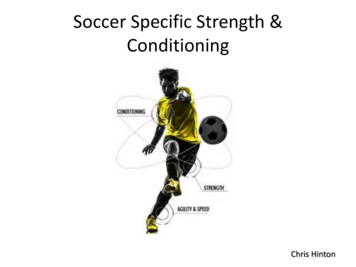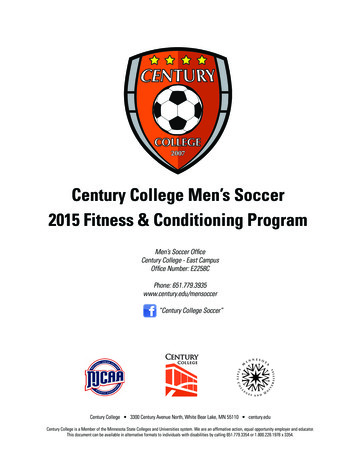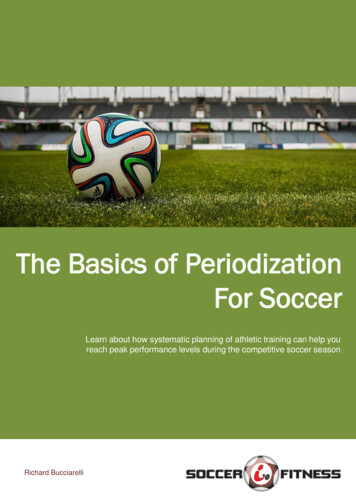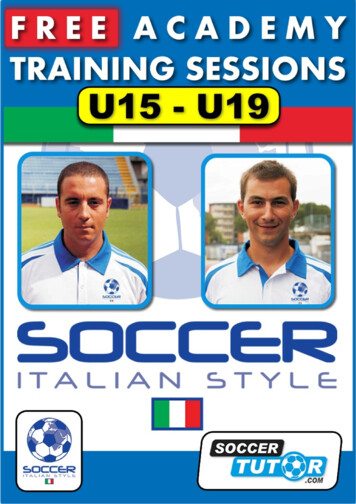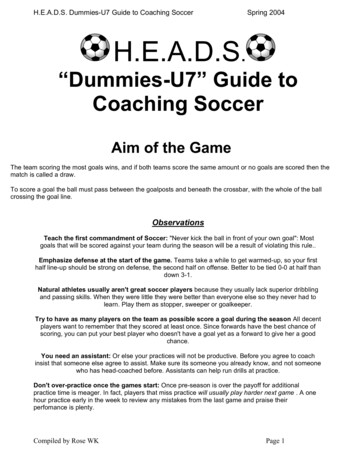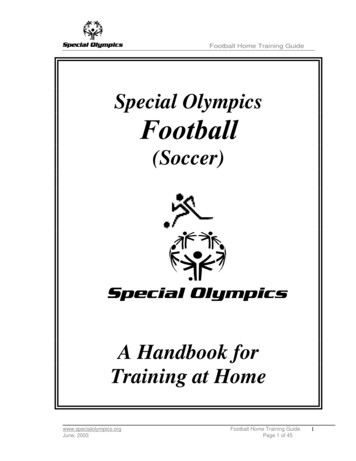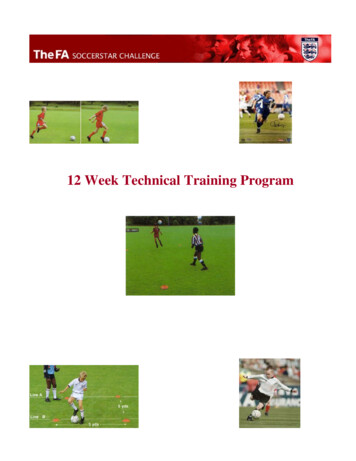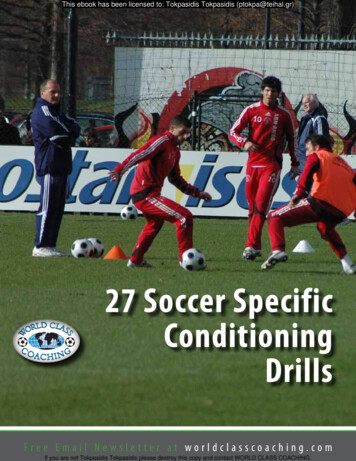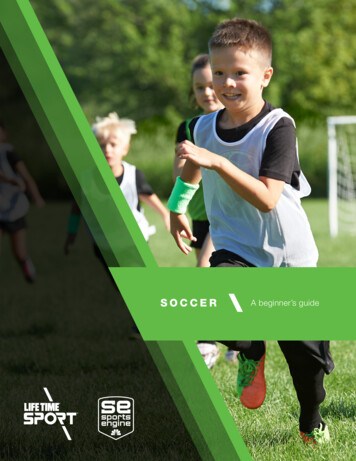
Transcription
SOCCERA beginner’s guide
Have a childstarting soccer?To a newcomer, any sport can seemoverwhelming. But, there’s a reason whysoccer is popular all over the world. Besidesjust being fun, it’s super accessible — allyou really need to play is a ball. It doeshelp, however, to understand a few of thefundamentals of the game, as well as whatyour child will want to get started. This guidehas all the information you need, so you canfeel prepared when your child steps onto thefield for the first time.1
WORDS OF ADVICEWe asked parents and coaches what they wish they had knownabout soccer from the get-go.Pick the right program for your child.There are tons of ways to play soccer, andeach will offer different playing styles, andtime and financial commitments. Be sure youunderstand what you’re signing up for beforeyou start. (For more on this, see Ways to Playon page 8.)A good coach can make all the difference.Look for a coach who can be a good rolemodel for your child, and who is accessible,candid, and a good communicator. It’s alsohelpful to understand the coach’s views onthings like playing time, discipline, playerdevelopment, and expectations for practiceand the off-season.Cheer on — don’t coach — your child.That is, at least when they’re at practice or agame. From the field, it can be hard to hearboth a parent or guardian and the coach.Leave this job to the coach to avoidconfusing the player.Sports aren’t a financial plan for college.Less than 1 percent of high school athletesreceive athletic scholarships, and only 0.03to 0.05 percent go on to play professionally.Encourage your child to play because he orshe enjoys it, and for the benefits of beingactive and learning life skills like teamwork,conflict resolution, and leadership.You can practice anywhere.Practice will help make your kid a better player, butit doesn’t have to be formal or structured. Grab aball and kick it around in the park, or juggle the ballon your feet in the house.Social development is as important as the game.Many people don’t realize that communication hasa large role in soccer. Your child will talk with theirteammates on the field, as well as with coachesand referees during games. This means your childwill not only meet new people, but he or she willlearn social skills, too.Be upfront with the coach.The more the coach knows about your kid,the better he or she will be able to coach them.If there’s anything you want him to know aboutyour kid’s background, skills, goals, or struggles,be open about it.Don’t over-think it.In the beginning, there really isn’t a lot of prepyou or your child needs to do before they canplay. Sign up and get the right equipment (for moreon this, see Dressed to Play on page 7), then letthe coach do the work of teaching your childhow to play the game.For more information, e highest-level professional soccer league in the United States is MajorLeague Soccer, which played its first season in 1996. It includes 20 teams,with 17 located in the United States and three in Canada.2
F U N D A M E N TA L S O F T H E G A M EWhile it’s not necessary to be well versed in allaspects of the game before your child starts, it ishelpful to understand some of the basics.TimeGames are playedin two halves orfour quarters, withbreaks in between.TeamThe number of playerson the field variesbased on your age.ScoreThe ball must enterthe goal, crossing thegoal line UTEH A LV E STEENS &A D U LT S35–45MINUTEH A LV E SJUNIOR3–5P L AY E R SYOUTH6–11P L AY E R STEENS &A D U LT S11P L AY E R S1POINTPER GOALFor more information, visit: community.sportsengine.com/soccer-fundamentalsA 2018 survey conducted across the Americas, Europe, the Middle East,and Asia showed soccer to be an interest of more than 40 percent of thepopulation, or 736 million people, a number that’s well above any other sport.3
THE BASIC RULESYou’ll want your child to do his or her best tofollow these six fundamental guidelines.No HandsUnless you’re the goalie or areattempting a throw-in, you’re notallowed to use your hands in play. Insoccer, hands refer to anything fromyour fingers to your shoulders.Throw-InsWhen the ball crosses the sidelineand goes out of bounds, a throw-inis taken by a member of the teamwho didn’t kick it out. The player willplant both feet on the ground, usingboth hands to throw the ball straightoverhead and back into play.Goal and Corner KicksThese are taken when the ball iskicked out of bounds behind thegoal line. If the offensive team kicksit out, the defensive team takes agoal kick from inside the goal box. Ifthe defensive team kicks it out, theoffensive team takes a corner kickfrom the corner nearest to where theball left the field.Direct and Indirect KicksEvery kick is considered an indirectkick unless it comes from a foul orhand ball. You can score on a directkick by kicking the ball directly intothe goal, whereas on an indirect kickthe ball must be touched by anotherplayer before you can score.Game in PlaySo long as the ball is on thefield inside of bounds, the gameis considered in play. The onlyexception to this rule is if the refereecalls for an infraction or offside(offside is applicable to ages 11 andolder only).FoulsIt’s the referee’s or coach’sresponsibility to monitor safe playand fouls, but, in general, the intentis to go for the ball, not the player.You can’t kick, trip, jump at, charge,strike, push, or hold an opponent. Ifa foul does occur, the team who wasfouled gets a free, direct kick at thelocation of the foul.For more information, visit: community.sportsengine.com/basic-soccer-rulesThe word soccer is thought to have originated in Britain some 200 years ago, comingfrom the official sport name, association football. The term soccer gained popularity in theUnited States, but by the 1980s Brits began to part with it, calling it football instead.4
GETTING INTO POSITIONSoccer positions vary based on age and competitive level. Young playersstart by trying all roles, then, as they get older and more positions areintroduced, they’ll likely find one they like to play more often than others.These are the four basic positions that set the foundation for the game.ForwardsThese players help to hold up or initiateplay and create scoring opportunities.DefendersThese players help protect thegoal, but do so from the fieldrather than the goal box.MidfieldersThese players help get the ball fromone side of the field to the other,playing both offense and defense.GoalieThis player’s job is to defend thegoal, blocking shots from theopposing team.For more information,visit: community.sportsengine.com/soccer-positionsSoccer is often referred to as the beautiful game, a phrase that was associated withthe sport after Brazilian soccer star Pelé called it such in Portuguese: jogo bonito.5
SOCCER TERMS EXPLAINEDCommunication is a big part of the game. Your child will be introducedto more words and phrases as they play and get into specific situations,but these are some of the first ones you might hear.Corner PassThis is how you’d set up a crossing pass. Asyou run down the field to score, kick the ballinto the corner for your teammate to go afterand kick back to you.Crossing PassThis is when you kick the ball from the corneror side of the field into the middle to one ofyour teammates in an attempt to score.Give-and-Go PassIf you have the ball and want to pass it to yourteammate so you can get open before gettingthe ball back, you’d yell out “give and go.”GolazoThis is what you’d shout if someone on yourteam made a really impressive goal. Golazo!Make a RunWhen your teammate throws in or kicks off theball, don’t just stand there and watch. Instead,move in a figure-eight position to get open,then run to an open space so they can passyou the ball.NutmegWhen the attacker kicks the ball through thedefender’s legs without the defender being ableto stop it.Open SpaceThe area of the field that no one from eitherteam is using. If you hear this, go to that spaceand own it.Overlap PassIf you have the ball and your teammate runspast you from behind and yells “overlap,” thatmeans you should pass the ball forward sothey can take the ball on the run.Support PassIf you have the ball but the other team isdefending close to you, your teammate mightyell “support,” indicating you should pass themthe ball, run to get open, then be ready for areturn pass.Use Your BodyIf the ball is coming at you, get in front ofit and use any part of your body (except yourhands, of course) to stop, redirect,or control the ball.For more information, visit: community.sportsengine.com/soccer-jargonThe FIFA World Cup is, along with the Olympics, one of sport’s twolargest events on a global scale, generating cumulative audiencefigures in the billions when it’s held every four years.6
D R E S S E D T O P L AYSoccer is a minimal equipment sport, but thereare a few items your child will need for the game.Shin GuardsThese come in different sizes basedon your child’s height and weight.Look on the package for a guide towhat size is best for your child. (Tip:shin guards are meant to be worninside their socks.)Soccer SocksThese socks are made of athleticintended materials and are longenough to fit over the length of theshin guards.CleatsGet soccer-specific cleats; neverchoose metal ones. If you’re juststarting out, tennis shoes are OK, butcleats are recommended.Athletic ClothesYour child will want to wear clothingthat’s easy to move around and runin, such as athletic shorts and aT-shirt, avoiding anything heavy orbaggy. If your child needs a jersey orpinnie, the team or organization willeither provide it or have it availablefor purchase.Water BottleThis isn’t required, but we definitelyencourage it. Your child will berunning around a lot, and hydrationis key.Soccer BallThe size of ball your child will need depends on his or her age.Follow these guidelines when purchasing.SIZE 3 (JUNIOR)SIZE 4 (YOUTH)S I Z E 5 ( A D U LT )for ages 8 and underfor ages 8 to 12for ages 13 and olderFor more information, visit: community.sportsengine.com/soccer-kitsThe number of high school girls who play socceris almost equal to the number of boys.7
WAY S T O P L AYThere are a lot of soccer programs available, each with varying types ofstructure and levels of commitment. Research all of your options first tofind the one that will be the right fit for your child.Club SoccerINTENSITYAge:8 and olderGood for:Those who want to increase their skillsand push themselves to play better.Commitment:Clubs typically play year-round in somecapacity, with practices three to fivetimes a week. They can also involvetravel at a metro, regional, or state level,and often require a larger financial andtime commitment.School SoccerAge:Middle and highschoolersStructure:These leagues are focused on skilldevelopment and competition.Players often need to try out and beassigned to a team. In this format,you’ll tend to see higher-levelplayers and coaches.INTENSITYGood for:Those who want to represent their school,playing with classmates and friends.Commitment:This tends to be the middle groundbetween community/recreational andclub soccer. There’s a mid-level financialcommitment, and you’ll likely practicedaily during the season.Structure:Like club soccer, school soccer is aformal league with tryouts. However,it does differ in that there’s usuallya team for everyone, based on skilllevel. Your competition will often beopposing schools.For more information, visit: sportsengine.com8
W A Y S T O P L A Y ( C O N T. )Community/Recreational SoccerAge:Young kidsto adultsGood for:Those who enjoy the game, but view itmore as a way to stay active with friends.Commitment:These leagues tend to be lower costand require a smaller time commitment.You’ll typically play for a defined season,practicing one to two times a week, withno expectations for off-season training.Life Time SportAge:5 and older,including teensand adultsINTENSITYStructure:The goal is to learn the basics of thesport, then just get out and play. It tendsto be less intense and competitionfocused. In general, anyone andeveryone can play, and coachesare typically volunteers or parents.INTENSITYGood for:Those who enjoy the playing aspect of soccer. Youcan choose to play soccer here for fun, or do so inaddition to another team you’re on.Commitment:There are no tryouts or committing to aseason — just come and play when itworks for your schedule. There are drop-inand day passes available, and you don’thave to be a Life Time member to play.Structure:The structure can be as tight orloose as you prefer. Knowledgeablecoaches are there to help withskill development or to justfacilitate play.For more information, visit: sportsengine.com9
Brought to you by:ABOUT SPORTSENGINEAt SportsEngine, we build applications and services to help coachesand volunteers spend less time on the administrative activities of theirorganization and more time teaching the qualities of sport to theirathletes. Learn more at sportsengine.com.ABOUT LIFE TIME SPORTBrought to you by Life Time, Life Time Sport offers a fresh take on sportswhere fun is the goal. It’s built upon the idea of offering convenient andcontinuous organized pickup soccer programming for all ages and skilllevels. Learn more at sport.lifetime.life.10
from the official sport name, association football. The term soccer gained popularity in the United States, but by the 1980s Brits began to part with it, calling it football instead. GETTING INTO POSITION Soccer positions

